15 Windows 10 tips to help you be more productive in school
These are the best features and tools that every student should know to stay productive in school using a Windows 10 device.
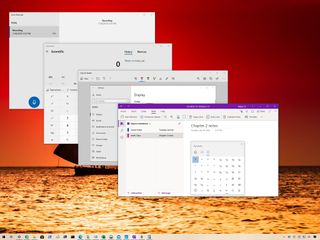
If you're looking for different ways to be a little more productive during the school year, Windows 10 comes with a lot of features and tools to help you stay focus and tackle those new projects, papers, and about any kind of schoolwork.
Some features are best to stay focused on the task, such as Focus Assist, Snap Assist, Night light, and virtual desktops. Others can help accomplish specific tasks like keyboard shortcuts, quick access to symbols, clipboard history, Timeline, and built-in apps designed for productivity, such as OneNote, Voice Recorder, Calculator, Snip & Sketch, and others.
Alongside the tools to help you stay productive, proper maintenance is also essential to make sure your device is ready for the school year. You can use these instructions to tune up your laptop just in time for school.
In this Windows 10 guide, we'll highlight 15 features and tools that every student should know to stay productive throughout the school year.
1. Stop notification overload with Focus assist
If you want to stay productive, you need to stay focus on the work you're doing. However, nowadays, it's difficult to concentrate as online services and apps continue to push notifications like never before adding unnecessary distractions.
On Windows 10, focus assist is a feature designed to minimize notifications to avoid interruptions, whether you're working on a school project or playing an exciting game.
To enable focus assist to stop notifications, use these steps:
Get the Windows Central Newsletter
All the latest news, reviews, and guides for Windows and Xbox diehards.
- Open Settings.
- Click on System.
- Click on Focus assist.
- Select the Priority only option to hide all notifications, except those in the priority list.

- (Optional) Click the Customize your priority list option.
- Specify the notifications that are allowed while focus assist is enabled.
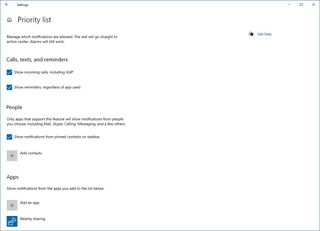
Once you complete the steps, notifications will no longer interrupt while you're in the middle of the creative process.
Schedule focus assist during school
Alternatively, you can also schedule focus assist in enabling automatically during school hours using these steps:
- Open Settings.
- Click on System.
- Click on Focus assist.
- Under the "Automatic rules" section, click the During these times option.
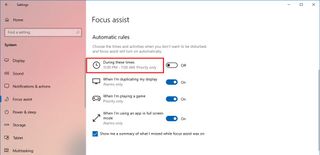
- Turn on the toggle switch.
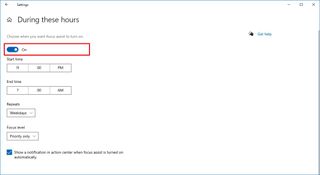
- Specify the start of the school work time.
- Specify the end time when you want to start receiving notifications again.
- Use the "Repeats" drop-down menu and select the Weekdays option (or the schedule that best suits your school hours).
- Use the "Focus level" drop-down menu and select the Priority only option.
After you complete the steps, notifications will be suppressed during the time you specified.
2. Insert symbols quickly
It'll eventually come the time when you need to insert a special language, punctuation, currency, or another type of symbol. Instead of doing an online search to copy and paste the symbol you need, you can use the Windows 10 emoji panel, which includes the ability to quickly insert symbols in addition to emoji and kaomoji.
To insert symbols on Windows 10, use these steps:
- Open an app (for example, Word or Microsoft Edge).
- In the text area, open the emoji panel using the Windows key + ; (semicolon) or Windows key +. (period).
- Click the Omega tab.
- At the bottom, select one of the categories to find a symbol:
- General punctuation.
- Currency symbols.
- Latin symbols.
- Geometric symbols.
- Math symbols.
- Supplemental symbols.
- Language symbols.
- Scroll down and select the symbol that you want to use.Quick note: As you start using this feature, the most frequently used symbols will appear in the "Most recently used" tab (clock button in the bottom-right) for quicker access.
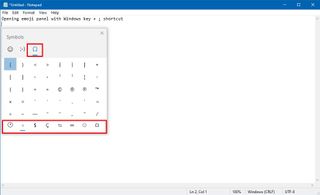
- Click the X button in the top-right or ESC key to exit the panel.
Once you complete the steps, the symbol will insert into the text document or post.
3. Pick up project where you left off with Timeline
On Windows 10, Timeline is a feature designed to make it easier to resume activities you're working in the past. For example, you can resume a website you were reading on the web, continue working on a Microsoft Word document, or pick up where you left off on virtually any app.
To get started with Timeline, use these steps:
- Click the Task View button in the taskbar.Quick tip: Alternatively, you can use the Windows key + Tab keyboard shortcut. Also, you can use the Windows key + S keyboard shortcut to open the Search home where you can view a shortlist of the most recent activities.

- Scroll below the current list of running applications to see the Timeline activities organized in chronological order.
- (Optional) Click the Yes button to see up to 30 days of events. (If the feature isn't enabled, you'll only see four days worth of activities.)
- Select an activity to resume your work.
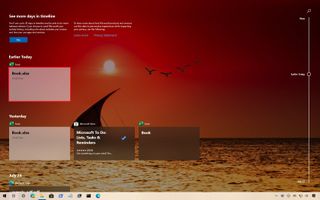
- (Optional) Click the Search button to perform a lookup for a specific activity
After you complete the steps, you can continue where you left off this week or four weeks ago.
4. Organize school work with virtual desktops
If you're working with a single display and need extra space, you can always connect a second monitor, but if it's not possible, you can still use a virtual desktop.
A virtual desktop is a powerful feature that allows you to create additional desktops to organize your tasks better and overcome the limitation of not enough display real estate.
Create a virtual desktop
To create a virtual desktop on Windows 10, use these steps:
- Click the Task View button in the taskbar.

- Click the New desktop button from the top-left corner.

- Right-click the desktop and select the Rename option.

- Specify a descriptive name for the desktop (for example, School Project) and press Enter.
- Select the newly created desktop to start working.
Once you complete the steps, you can start using the new desktop.
Switch between desktops
To switch between virtual desktops, use these steps:
- Click the Task View button in the taskbar.
- Select the virtual desktop.

Alternatively, you can use the Windows key + Ctrl + Left arrow or Windows key + Ctrl + Right arrow to quickly jump between desktops.
Transfer apps between desktops
To move apps between virtual desktops, use these steps:
- Click the Task View button in the taskbar.
- Right-click the running application, select the Move to option and choose the virtual desktop.
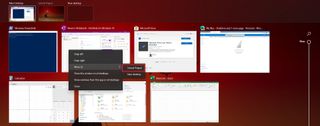
- (Optional) Select the Show this window on all desktops or Show windows from this app on all desktops option.
If you don't need the virtual desktop anymore, click the close (X) button on the desktop from the Task View.
5. Work more efficiently with multiple windows using Snap assist
On Windows 10, Snap assist is a feature that allows you to organize the space on the screen more efficiently to improve productivity. Using this feature, you can quickly snap windows to the sides (or corners) perfectly aligned using the mouse, keyboard, and touch without needing to resize and position them manually.
Snap two windows
To snap two windows side-by-side, use these steps:
- Click the title bar of a window.
- Drag the window to the left or right edge of the screen.

- Select the thumbnail of the second window that you want to run side-by-side.
If you don't see the window thumbnail in the list, open the window manually, and drag it manually to the opposite side.
Alternatively, while the window is in focus, you can also use the Windows key + left arrow keyboard shortcut to snap a window to the left, or Windows key + right arrow keyboard shortcut to snap a window to the right. If you have a multi-monitor setup, you can press the right or left arrow twice to snap the window in a second monitor.
Snapping three windows
To snap three windows, use these steps:
- Click the title bar of a window.
- Drag the window to the left or right edge of the screen.
- Click the title bar of a second window.
- Drag the window to the bottom corner.

- Click the title bar of a third window.
- Drag the window to the top corner.
After you complete the steps, you'll end up with three apps perfectly aligned on the screen.
Snapping four windows
To snap up to four windows, use these steps:
- Click the title bar of a window.
- Drag the window to any of the four corners of the screen.
- Repeat the steps and snap three additional windows to the remaining available corners.
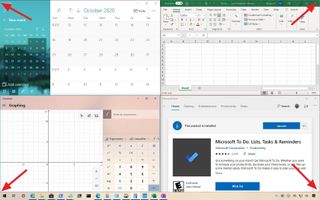
Also, you can use keyboard shortcuts to snap windows into the corners. For instance, if you want to snap a window in the top-left corner, use the Windows key + left arrow + top arrow.
Snap Assist works with keyboard and mouse, but you can also snap windows using touch gestures by tapping and dragging a window to the left and right edges or corners of the screen.
6. Save multiple items for later use with Clipboard
If you usually copy and paste the same text and images, you should be using the new clipboard experience, which keeps tracks of the content you copy and includes an interface to view, paste, and organize content.
Enable Clipboard
The clipboard experience comes disabled by default, and you can enable it with these steps:
- Open Settings.
- Click on System.
- Click on Clipboard.
- Turn on the Clipboard history toggle switch.
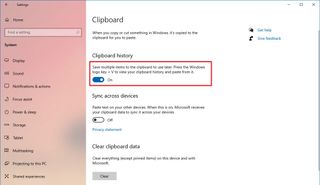
- (Optional) Turn on the Sync across devices toggle switch.
Once you complete the steps, text, and images that you copied will be stored in the clipboard experience.
Use Clipboard
To use clipboard on Windows 10, use these steps:
- Select some text or an image.
- Right-click the selection and select the Copy (or Cut) option.

- Open destination app where you can paste the content.
- Use the Windows key + V keyboard shortcut to open the clipboard history.Quick tip: While in the clipboard experience, you can click the (three-dotted) menu button to delete, pin, or clear all the contents in the history.
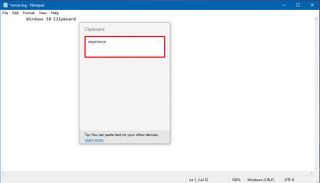
- Select the content you want to paste.
After you complete the steps, the content you selected will insert in the document.
7. Automate common tasks with Windows 10 shortcuts
On Windows 10, keyboard shortcuts can help you to work more efficiently as they provide a quick way to navigate and operate features using a single key combo, which otherwise will take more time to complete the same task using the mouse.
You can use tons of keyboard shortcuts to work more quickly, but these are the essential ones that will help you stay productive in school:
| Keyboard shortcut | Action |
|---|---|
| Ctrl + A | Select all content. |
| Ctrl + C (or Ctrl + Insert) | Copy selected items to clipboard. |
| Ctrl + X | Cut selected items to clipboard. |
| Ctrl + V (or Shift + Insert) | Paste content from clipboard. |
| Ctrl + Z | Undo an action, including undelete files (limited). |
| Ctrl + Y | Redo an action. |
| Ctrl + Shift + N | Create new folder on desktop or File Explorer. |
| Alt + F4 | Close active window. (If no active window present, then shutdown box appears.) |
| Ctrl + D (Del) | Delete selected item to the Recycle Bin. |
| Shift + Delete | Delete selected item permanently skipping Recycle Bin. |
| F2 | Rename selected item. |
| ESC | Close current task. |
| Alt + Tab | Switch between open apps. |
| PrtScn | Take screenshot and stores it in clipboard. |
| Windows key + I | Open Settings app. |
| Windows key + E | Open File Explorer. |
| Windows key + A | Open Action center. |
| Windows key + D | Display and hide the desktop. |
| Windows key + L | Lock device. |
| Windows key + V | Open Clipboard bin. |
| Windows key + Period (.) or semicolon (;) | Open emoji panel. |
| Windows key + PrtScn | Capture full screenshot in the "Screenshots" folder. |
| Windows key + Shift + S | Capture part of the screen with Snip & Sketch. |
| Windows key + Left arrow key | Snap app or window left. |
| Windows key + Right arrow key | Snap app or window right. |
8. Reduce eye strain with Night light
If you usually stay up late working on school projects, you should use "night light" to stay productive and reduce eye strain.
Computer displays produce a blue light that can alter your internal body clock and affect the production of melatonin, causing disruption of your sleep quality and discomforts in your eyes.
On Windows 10, night light is a feature that reduces the amount of blue light on the screen by using warmer colors that can help minimize eye strain and help you fall asleep after staying up late working on a school project.
To configure night light on Windows 10, use these steps:
- Open Settings.
- Click on System.
- Click on Display.
- Under the "Color" section, click the Night light settings option.
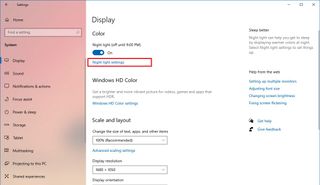
- Use the slider to select the warm intercity. (The more the intensity, the less blue light the screen will emit.)

- (Optional) Turn on the Schedule night light toggle switch.
- (Optional) Select the Set hours option.
- Specify the start time to enable night light.
- Specify the end time to disable night light.
Once you complete the steps, night light will activate automatically in the schedule you specified. Alternatively, you can always enable the feature using the Night light button in Action Center (Windows key + A keyboard shortcut).
9. Capture screenshots with Snip & Sketch
Screenshots can come in handy in many situations, especially in school. You can use them to quickly save a piece of content for later review, such as receipt, form, text, etc. You can use them to complement a paper you're working with a particular image. You can use them to save something you don't want to forget, and more.
If you're using Windows 10, you don't need a third-party tool, since there's a built-in app known as Snip & Sketch to take screenshots of the entire screen, active windows, or particular section of the screen.
To take a screenshot on Windows 10, use these steps:
- Open Start.
- Search for Snip & Sketch, click the top result to open the experience.
- Click the New button in the top-left corner.

- Select the type of snip you want to use, including:
- Rectangular Clip.
- Freeform Clip.
- Fullscreen Clip.
- Capture the screenshot.
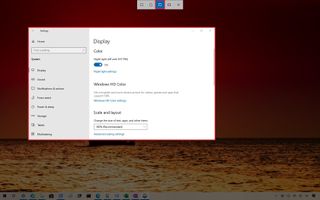
- Edit the screenshot as need it with the option available, such as touch writing, marker, or image cropping.
- Click the Save button from the top-right corner.Quick tip: If you want to paste the screenshot in a Word document or OneNote, you can use the Copy button to upload the content to the clipboard.

- Confirm the name of the file.
- Click the Save button.
After you complete the steps, you can repeat the instructions to take additional screenshots.
Quicker access to snipping
To take screenshots with Snip & Sketch using the "Print Screen" dedicated key in the keyboard, use these steps:
- Open Settings.
- Click on Ease of Access.
- Click on Keyboard.
- Under the "Print Screen shortcut" section, turn on the Use the PrtScn button to open screen snipping toggle switch.
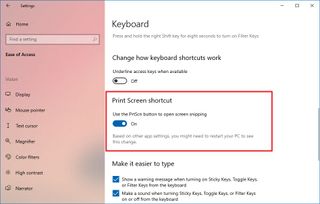
Once you complete the steps, you can use the Print Screen key to take screenshots.
10. Open files with correct app
Windows 10 includes apps to handle almost every file format you can imagine, but many people have their preferences and needs when it comes to using an app to complete a task. For example, you may not want to use Microsoft Edge as your default web browser experience on Windows 10, but rather Google Chrome or Mozilla Firefox. Or you have a photo editing tool because you don't want to use the Photos app.
If you'd like to quickly open a specific file with a particular app, or specify your default browser, Windows 10 includes the settings to decide the app you want to use as default.
To set an app as default on Windows 10, use these steps:
- Open Settings.
- Click on Apps.
- Click on Default apps.
- Under the "Choose default apps" section, select the app you want to change the default. For example, Web browser.
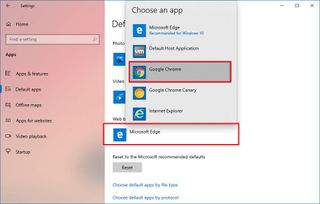
- Select an app from the list to make it the new default.
After you complete the steps, when trying to open a file, it'll launch with the app you specified without additional steps.
11. Tackle math homework with Calculator
If your schoolwork includes a lot of math homework, you don't need to purchase an expensive scientific calculator since Windows 10 includes one built-in to help you quickly tackle any mathematical problem.
To switch modes with the Calculator app, use these steps:
- Open Start.
- Search for Calculator and click the top result to open the app.
- Click the menu button from the left side.
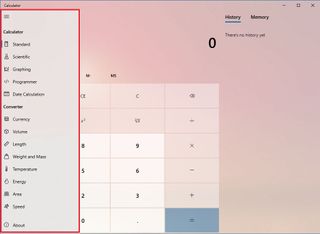
- Select one of the available calculator modes, including:
- Standard – provides an interface to perform basic mathematics operations.
- Scientific – offers all the advanced options to calculate problems in science, engineering, and mathematics.
- Graphing – provides the options needed for solving simultaneous equations, plotting graphs, and performing tasks with variables. (This mode is only available on device running the May 2020 Update or higher.)
- Programmer – lets you work with binary, hexadecimal, octal, and decimal numbers and more.
- Date Calculation – offers the options to perform day calculations, such as different between days, and add and subtract days.
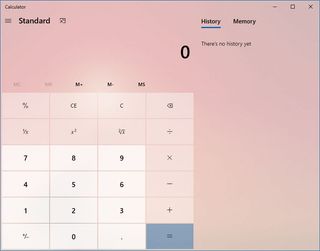
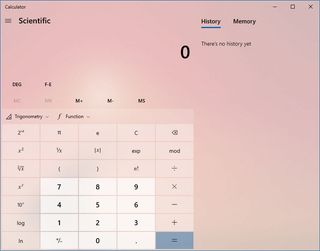


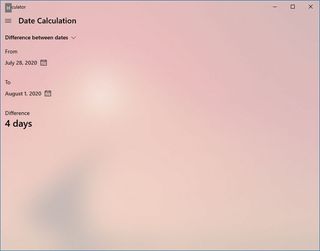
In addition to the different calculator modes, the apps also include 13 different data converter modes, including currency, volume, length, weight and mass, temperature, energy, area, speed, time, power, data, pressure, and angle.
12. Control flow of email and events with Mail and Calendar
It's not uncommon for people to manage different email accounts to keep things separate. For instance, you may get an email from your school while maintaining another for your personal stuff and another for work.
If you have multiple accounts, managing them individually using the respective web portals can be time-consuming. However, Windows 10 includes the Mail and Calendar apps that allow you to manage all your emails and calendar events (no matter the service provider) from a single experience.
Set up Mail app
To get started with the Mail app, use these steps:
- Open Start.
- Search for Mail and click the top result to open the app.
- Click the Add account button.
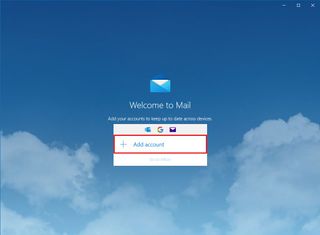
- Select an email account.Quick tip: If you have a particular school email address. You'll probably need to select the "Office 365" or "Other account" option, confirm the email address and password to continue.

- Click the Done button.
Once you complete the steps, you can start managing your emails more efficiently with the Mail app.
Add multiple email accounts
If you have multiple email accounts, you can add them all to the Mail app using these steps:
- Open Mail app.
- Click the Settings button at the bottom of the page.
- Click the Manage accounts option.
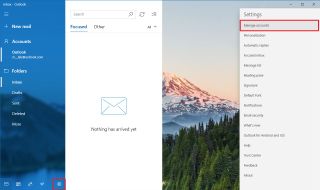
- Click the Add account option.
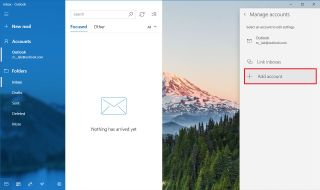
- Select the service (Outlook, Office 365, Google, Yahoo, iCloud, or POP/IMAP) to connect the account.
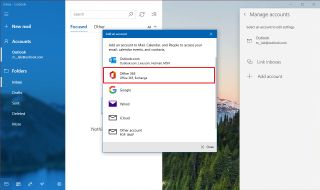
- Continue with the on-screen directions to complete the task.
After you complete the steps, you may need to repeat the steps to connect additional email accounts.
Once adding the accounts, you'll be able to manage all your email messages from a single experience without the need to log in to different accounts on the web.
Set up Calendar app
As you add new accounts to the Mail app, they'll also be added to the Calendar app automatically. However, you can always use the same steps outlined above to add additional accounts within the Calendar experience.
To get started with the Calendar app, use these steps:
- Open Start.
- Search for Calendar and click the top result to open the app.
- Check the calendars you want to see from the list of the left side.
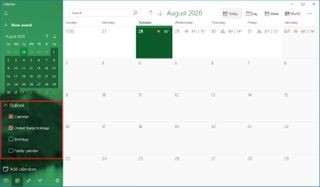
- Clear the calendars you don't want to see.
- (Optional) Click the Add calendars button from the bottom-left side.
- Select the calendar you want to add. For example, holidays, sports, or TV calendars.
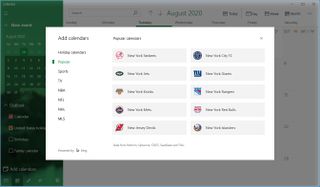
- Click the New event button fromQuick tip: Within the app, you can also use the Ctrl + N keyboard shortcut to create a new event.
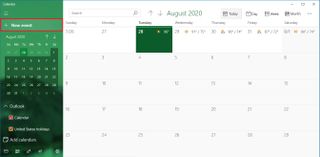
- Under the "Details" section, specify a descriptive title for the event.
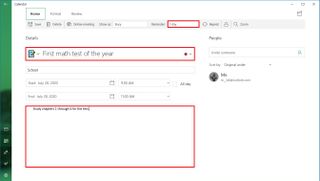
- (Optional) Click the drop-down menu on the left and select a related icon to make it even easier to find the event.
- (Optional) Use the Calendar drop-down menu and choose the account to which you want to save the event.
- Specify the physical location where the event will take place (if applicable).
- Use the Start option to specify a start date.
- Use the drop-down menu on the left to select a start time.
- Use the End option to specify the end date.
- Use the drop-down menu on the left to choose an end time.
- (Optional) Check the All day option if the event uses the entire day.
- In the bottom section, add all the details about the event.
- (Optional) Use the Show as drop-down menu to select a visual cue, including:
- Free.
- Working elsewhere.
- Tentative.
- Busy.
- Out of office.
- Use the Reminder drop-down menu to select how long before you should receive an alert about the event.
- Click the Save button in the top-left.
Calendar is a straightforward app, and it includes all the essential features to keep on top of your events. The app consists of different views (Today, Day, Week, Month, and Year) to see your events and a search box to find calendar events quickly. The experience to create new events provides all the features and settings you come to expect to create and share events and even calendars to stay on top of holidays and never miss a show or sports event.
13. Store school files in OneDrive
Part of being productive in school includes having the ability to access your files no matter the device or location quickly, and OneDrive is arguably the best cloud storage to connect all your files for anyone using Windows 10 computers as well as Android and iOS devices.
When you use OneDrive, you can store and protect your school and personal files in the cloud, share them with other people, and access your files from anywhere.
To configure OneDrive on a laptop to protect your school documents and other files, use these steps:
- Open Start.
- Search OneDrive and click the top result to open the app.Quick Tip: If you don't find OneDrive on your computer, download the OneDrive client from Microsoft, and double-click the file to install it.
- Using the setup experience, enter your email address.
- Click the Sign in button.

- Confirm your Microsoft account password.
- Click the Sign in button.
- Click the Next button.
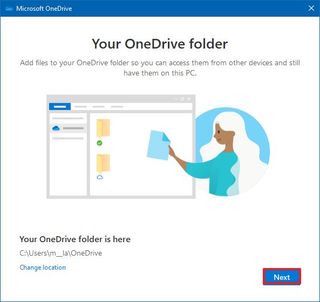
- (Optional) Clear the local folders you don't want to backup in the cloud.Quick note: Although this is an optional step, it's recommended to backup your personal folders to the cloud whenever possible. Otherwise, if you have important files in the Desktop, Documents, or Pictures folders, you'll need to transfer them manually to the OneDrive folder.
- Click the Continue button.

- Click the Not now button.
- Click the Next button.
- Click the Next button again.
- Click the Next button one more time.
- Click the Later button.
- Click the Open my OneDrive folder button.
After you complete the steps, you can start saving files inside the OneDrive folder to upload them to the cloud automatically, and then they'll be available anywhere, including from another Windows 10 computer, macOS, iOS, and Android devices.
Share file
To share a file with OneDrive, use these steps:
- Open the OneDrive folder with File Explorer.
- Right-click the file and select the Share option.
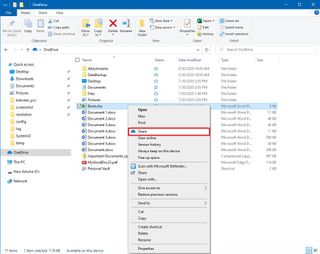
- Click the Anyone with the link can view option.
- (Optional) Clear the Allow editing option.
- Click the Apply button.
- Confirm the email of the person who will be accessing the file.

- Click the Send button.
Once you complete the steps, the recipient will receive an email with a link to the file.
14. Take notes of anything with OneNote
OneNote is your personal digital notebook to capture pretty much anything. The app isn't meant to replace your word processing or similar apps. Instead, it's a notebook to take notes or record audio in class, which you can then refer to complete your homework or research paper. You can also use it to brainstorm ideas, create lists of things you need to complete or remember later, and thanks to its digital ink capabilities, you can sketch on a touched-enabled device.
You can also share notebooks to collaborate with other people, organize your notes in sections, move pages around, take a picture of paper notes, and import them into your notebook, and a lot more.
The app is free without the need to install Office, and you can get started using these steps:
- Open Start.
- Search for OneNote and click the top result to open the app.
- Click the Get started button.Quick tip: If you want to store your notes in a different account, click the change account option, click the Personal Microsoft or Work or school account buttons, and continue with the on-screen directions to complete the setup.
- Click the Add section option at the bottom of the page.

- Confirm the name for the section, for example, Math Class and press Enter.
- Repeat step No. 3 and 4 to create additional sections as you need to work more efficiently in shcool.
- Right-click on each of the sections, select the Section Color menu, and color to better identify the section.
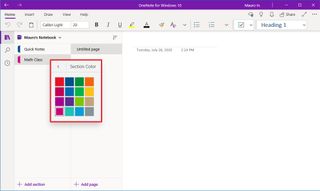
- Select a section.
- Click the Add page option.
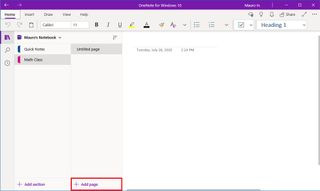
- Confirm a new name for the page by specifying a title for the page (above the date and time).

- Repeat step No. 7 through 9 to create additional pages as needed.
Once you complete the steps, you can start using OneNote to take school notes, work in research papers, or for anything you need.
The app offers all be basic features you'll ever need to take notes with the ribbon menu, which includes four main sections. The "Home" tab has the most common tools, such as undo and redo, fonts, highlighter, an option to clear formatting, and tags, which will come in handy to create To-Do lists as well as mark things as important or question.
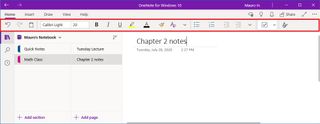
In the "Insert" tab, you can create tables, attach files, insert images, start a voice recording, work with mathematical equations, and more.

The "Draw" tab includes a bunch of features designed for touch-enabled devices, and the "View" tab houses tools like Immersive Reader, zoom, translation, and the ability to change the page rule lines for a more real notebook experience.
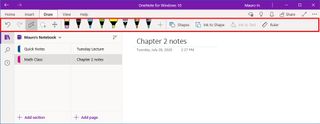
15. Record lectures using Voice Recorder
The Voice Recorder app on Windows 10 is a quick and convenient solution to record lectures in school, conversations, and record interviews, and podcasts.
To record a lecture with the Voice Recorder app, use these steps:
- Open Start.
- Search for Voice Recorder and select the top result to open the app.
- Click the Record (microphone) button to start the recording.
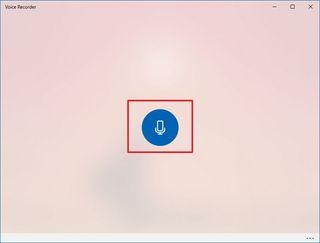
- Click the Pause button to stop the recording without terminating the session.
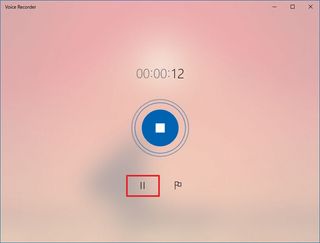
- Click the Flag button to mark a section to reference later.
- Click the Stop button to terminate the recording.
- Select the track from the left-side.
- Click the Play button to listen to the audio and transcribe the content as needed.
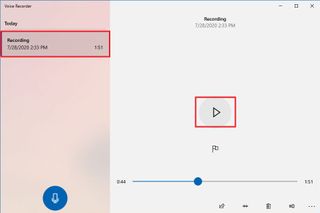
- Click the Rename button at the bottom-right corner.
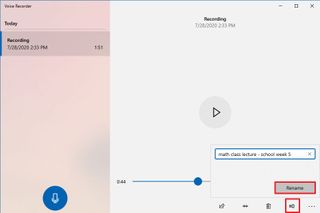
- Specify a descriptive name for the recording to make it easier to find it later.
- Click the Rename button.
After you complete the steps, the recordings will be stored in the Sound recordings folder inside "Documents." You can always access the file location by right-clicking the track and selecting the Open file location option.
If you use OneNote, you may want to use the app built in voice recorder feature, instead of the Voice Recorder app, as the recordings will sync with your notes across devices (thanks Andrew G1 for the tip). However, if you prefer the Voice Recorder app, and you want your recordings to sync accross devices, either transfer the files to your OneDrive folder or enable the OneDrive backup feature for the "Documents" folders as shown in this guide.
Wrapping things app
Although Windows 10 includes tons of ways to keep you productive, and you can install a lot of other tools, we're focusing this guide only on the tools built into the OS.
Of course, you can always purchase a Microsoft 365 subscription to download and install Office to access the most productive tools in the world, such as Word, Excel, and PowerPoint. Or you can download tools, such as Microsoft To-Do to manage all of your tasks.
Mauro Huculak is technical writer for WindowsCentral.com. His primary focus is to write comprehensive how-tos to help users get the most out of Windows 10 and its many related technologies. He has an IT background with professional certifications from Microsoft, Cisco, and CompTIA, and he's a recognized member of the Microsoft MVP community.

